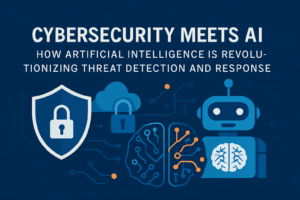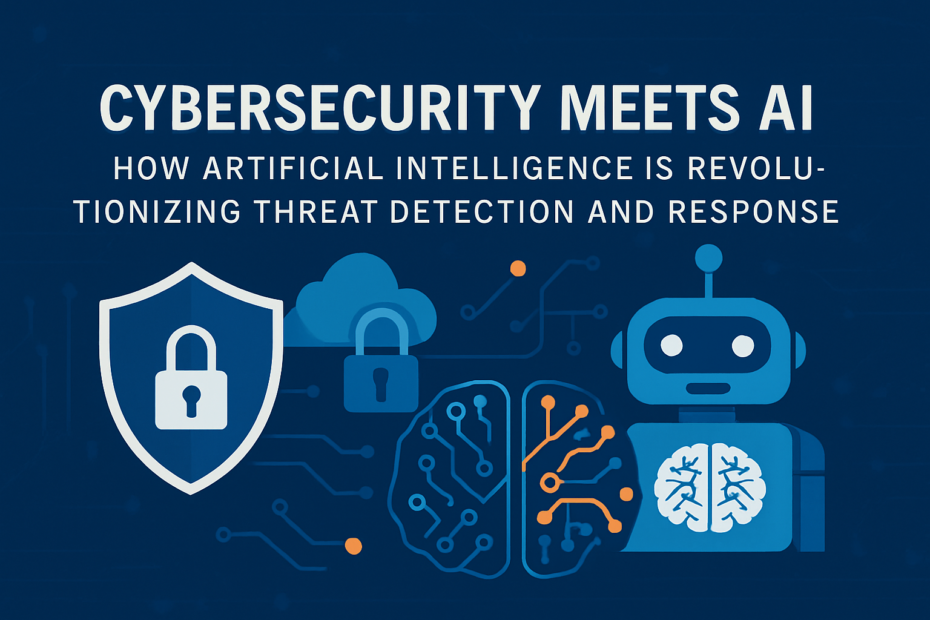
After listening the word “cybersecurity” it feels like something only IT folks worried about. Install some antivirus software, don’t click shady links, and boom—you’re safe, right?
Not anymore.
Today’s cyber threats are on a whole new level. Hackers aren’t just sending scam emails from their basements. They’re using AI, automation, and some serious social engineering skills to launch attacks that are faster, sneakier, and way more damaging. Whether you’re a small business or a big enterprise, you’re a target.
So how do you keep up when the bad guys are getting smarter? You bring in reinforcements—and that’s where Artificial Intelligence steps in.
Let’s break it down.
Why Traditional Cybersecurity Just Isn’t Enough Anymore
We’ve hit a point where cyberattacks happen so quickly and in so many different ways, that human teams simply can’t keep up.
Imagine trying to manually monitor millions of data points every second, across emails, user accounts, cloud servers, and mobile devices. That’s what security teams are up against.
Worse, attackers are using automation and AI to find vulnerabilities faster than defenders can patch them. They’re sending out phishing emails that sound almost exactly like your boss, or slipping malware into supply chains before it ever hits your network.
It’s just too much for people alone to handle.
What Exactly Does AI Do in Cybersecurity?
AI in cybersecurity isn’t about replacing people—it’s about giving your security team a serious power-up.
Here’s how it helps:
- Detects threats faster: AI can scan for weird patterns in your system and spot trouble before it explodes into a full-blown crisis.
- Flags unusual behavior: Like when a user suddenly logs in from another country or tries to download a massive chunk of sensitive data.
- Automates responses: If a device looks compromised, AI can isolate it before anything spreads.
- Cuts through the noise: Instead of alerting you to every tiny blip, it prioritizes the stuff that actually matters.
Think of it as your digital watchdog. It never sleeps, it doesn’t get overwhelmed, and it learns from every attack it sees.
Real Talk: What Makes AI So Good at This?
The magic of AI is in how it learns. Traditional systems rely on fixed rules: “If X happens, block Y.” That’s helpful, but predictable—and attackers know how to work around that.
AI is different. It doesn’t need rigid rules. Instead, it studies how your systems normally behave and learns what “normal” looks like. When something odd happens, it raises a red flag—even if that exact situation has never happened before.
For example, say an employee in HR suddenly tries to access engineering files at 3 AM from a new location. That’s suspicious. AI won’t just block it blindly—it’ll consider the context and alert your team with a solid reason why.
What Happens When AI Takes the Wheel?
Here’s the wild part: some AI systems don’t just detect threats—they deal with them on the spot.
Say someone’s laptop gets infected with ransomware. Instead of waiting for IT to react, the AI system might automatically cut off the device from the network to stop the spread. Some even shut down specific services, revoke access, or start backing up files before damage occurs.
It’s like having a fire alarm that also grabs the extinguisher and starts spraying before you even smell smoke.
Why This Is a Game Changer
There are a bunch of reasons why companies—big and small—are jumping on the AI train for cybersecurity:
- It’s fast. Threats move in milliseconds. AI keeps up.
- It scales. Got thousands of endpoints and data streams? No problem.
- It gets smarter. The more threats it sees, the better it gets.
- It saves time. Your security team can focus on big-picture strategy instead of chasing every little alert.
In short, it helps you stay proactive instead of reactive.
But AI Isn’t a Magic Wand
Let’s not pretend it’s perfect.
AI systems can make mistakes. They’re only as good as the data you feed them. If your training data is off, they can either miss real threats or flag normal behavior as risky—like accusing Karen in finance of being a hacker because she downloaded a big spreadsheet.
Also, hackers are getting creative. Some are now trying to “trick” AI systems using special code or weird behavior patterns that fool the machine.
And then there’s the whole privacy thing. Monitoring user behavior can raise eyebrows. People don’t want to feel like they’re constantly being watched by a robot.
The Best Cybersecurity Setup? Humans + AI
The sweet spot isn’t choosing between humans or AI—it’s getting them to work together.
AI is fantastic at the grunt work: scanning logs, connecting dots, identifying patterns. But human security experts bring context, experience, and judgment—especially when attacks get weird or personal.
It’s kind of like having a super-smart assistant who watches everything and points out the odd stuff, while you decide what to do about it.
Where We’re Seeing AI in Action
This isn’t theory. It’s happening everywhere:
- Banks are using AI to catch fraud in real time—sometimes before a single dollar is lost.
- Hospitals are spotting ransomware attacks and locking things down before patient data is stolen.
- Retailers are catching bots and fake accounts that mess with prices or scoop up limited-edition drops.
- Even governments are using AI to spot foreign cyberattacks before they happen.
The best part? You don’t have to be a Fortune 500 company to use this tech. AI-driven security tools are becoming more accessible and affordable every day.
Looking Ahead: What’s Next?
We’re just scratching the surface of what AI can do in this space. In the next few years, we’re likely to see:
- Smarter explanations: AI that tells you why it flagged something, in plain English.
- Collaborative learning: Systems that learn from threats across multiple organizations without sharing sensitive data.
- AI-on-AI battles: As attackers start using AI too, we’ll see digital showdowns that look like sci-fi.
Bottom line? AI isn’t just helping with cybersecurity—it’s becoming essential to it.
Final Thoughts
Cybersecurity today is a battlefield. And AI is quickly becoming one of the best weapons defenders have.
It’s fast, scalable, and smart enough to spot things humans might miss. But it’s not about replacing people—it’s about empowering them to make better decisions, faster. If you’re serious about staying ahead of cyber threats, bringing AI into your defense strategy isn’t a “maybe”—it’s a must.
Whether you’re running a business, managing IT, or just trying to keep your data safe, now’s the time to get familiar with how AI can help. Because the threats aren’t slowing down—but with the right tools, you don’t have to either.
